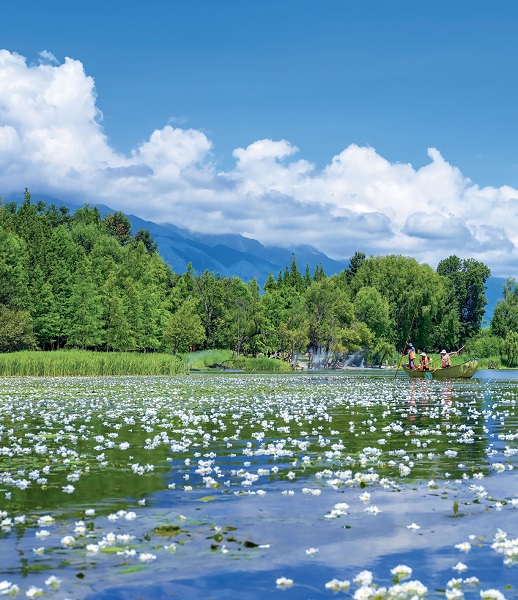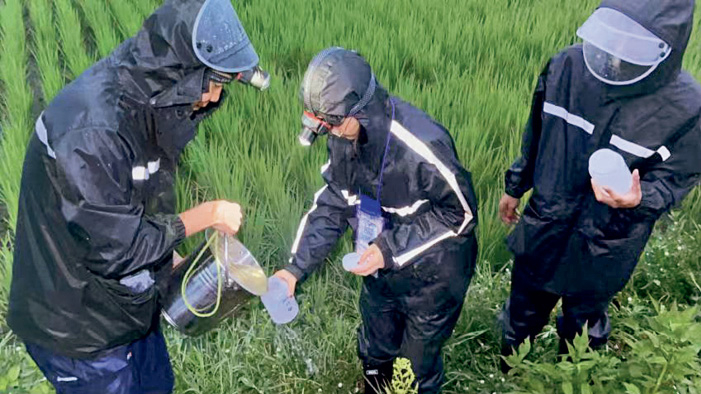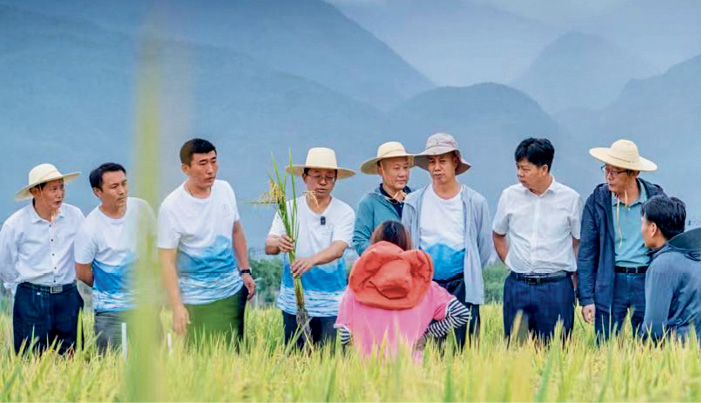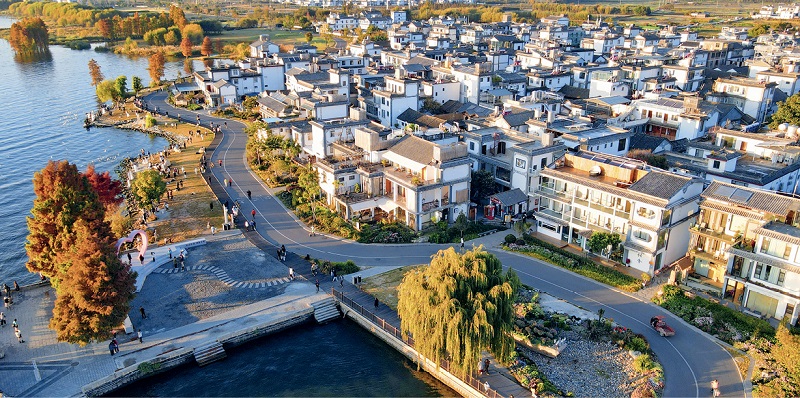The Guardians of Mother Lake
Agricultural scientists find a balanced way to protect ecology and raise farmers’ income.

Blooming Erhai waterweed flowers.
His skin has turned dark and his shoes are covered with dust. Donning a straw hat, Zhang Fusuo, an academician at the Chinese Academy of Engineering and a professor at China Agricultural University (CAU), says he has now become a villager, rather than a professor.
Zhang lives in Gusheng, a 2,000-year-old village located in the Erhai Lake basin in the picturesque Dali Bai Autonomous Prefecture in southwest China’s Yunnan Province. While the lake received much attention for ecological preservation, the basin suffered from high pollution, high deposits of nitrogen and phosphorus in the soil, and low agricultural yields. In the past, the protection efforts for the Erhai Lake were not coordinated with agricultural development, and therefore did not lead to an increase in farmers’ income. Zhang decided to change the situation.
To explore a way to combine Erhai Lake preservation with high-quality agricultural development, CAU, Yunnan Agricultural University and the government of Dali Bai Autonomous Prefecture jointly established the village’s first Science and Technology Backyard (STB) in February 2022. “The goals of the Gusheng Village STBs are not only to maintain the purity of the Erhai Lake, but also to support local agricultural development,” Zhang told the reporter.
The plant nutrition specialist has established 14 STBs in Gusheng Village, together with other teachers and students of CAU.

Researchers collect water samples amid heavy rain in Gusheng Village, Dali, in August 2022.
Source of Pollution
Dali is nicely encircled by mountain ranges on the south, west, and east. The Erhai Lake, covering an area of 252 square km, sits majestically in the center. The township, with beautiful natural scenery and the distinctive culture of the Bai ethnic group, is popular among tourists. However, the mother lake of the Dali people became so polluted in the 1980s that it emitted a putrid smell. Then, it saw three major blue-green algae outbreaks in 1996, 2003 and 2013.
Identifying the sources of the pollution was the primary problem faced by the teachers and students in the Gusheng Village STBs. “Understanding where pollutants came from was a top priority for protecting the Erhai Lake,” Zhang said.
Most of the water flowing into the Erhai Lake comes from Cangshan Mountain. In order to find out the source of pollution, they walked or rode electric trikes around the Cangshan Mountain and the Erhai Lake to observe the water system, set up monitoring points, and conduct sampling analysis.
“We have to be ready to visit any time during the day or the night. Every time it rains, especially if there is a rainstorm, teachers and students need to go out for sampling,” Zhang said.
Since April 2022, the Gusheng Village STBs have dispatched more than 1,000 personnel to conduct synchronous monitoring of water quantity and quality, collected more than 3,000 samples, and analyzed more than 20,000 water sample indicators, providing strong data support for tracing the source of surface pollution in the Erhai Lake.
“The detection results were different from what we had thought. We found that pollution from farming did not account for 70 percent as estimated by the government, but 30 percent to 50 percent. The rest of the water pollution comes from rural garbage dumps, house yards, vegetable fields, etc.,” Tang Bowen, a graduate student of CAU, told the reporter. He is mainly responsible for tracing and monitoring the source of pollution.
The elimination of village pollution should start from the source. Tang and his classmates actively mobilized villagers to participate in waste sorting and disposal.
“Now we can receive 30 kg of kitchen waste almost every day, and turn it into organic fertilizer through low-cost treatment methods to turn waste into treasure,” Tang said.
“Nowadays, the lake water is getting clearer year by year, and sometimes we can see crucian carps jumping out of the lake,” Liang Wanqiao, a villager of Gusheng, said.
Yang Guozong, secretary of the Dali Bai Autonomous Prefectural Committee of the Communist Party of China (CPC), said that at the present moment, the water quality of the 27 main rivers entering the Erhai Lake has reached state standard, and the transparency of the lake has risen to the highest level in nearly 20 years.

Zhang Fusuo (fourth left) and his colleagues check the growth of rice in Gusheng Village on September 24, 2022.
Ecological Agriculture
The fertile plain of the basin extends from the foot of Cangshan Mountain to the bank of the Erhai Lake. In the fields of Gusheng Village, a sign is erected at each paddy field, which states the paddy variety, and the type and amount of fertilizer used. The green, high-value experimental plantation field of Zhang’s team is located here.
“A year ago, we wanted to help the local village to control the pollution of the Erhai Lake. A year later, we changed our minds,” said Jin Kemo, a teacher in charge of the Gusheng Village STBs, and an associate professor of CAU. Now, in addition to guarding the blue water of the Erhai Lake, the Gusheng Village STBs are helping the village to find ways of growing crops that are both environmentally friendly and economically rewarding.
Gusheng Village has a population of over 1,400. In the past, garlic cultivation was the main source of income for the local farmers. At that time, the planting area of garlic in the Erhai Lake basin was nearly 200,000 mu (13,333 hectares), with a yearly profit of over RMB 5,000 (US $702) per mu (0.067 hectare), far higher than that of general grain cultivation. However, garlic cultivation needs abundant water, fertilizer and pesticide, which undoubtedly creates pollution in the Erhai Lake. A large amount of pesticide and fertilizer remain in the farmland, and flow into the lake during the rainy season.
“The environment around the Erhai Lake has improved, but the villagers around the Erhai Lake have not been benefitted, which is not the result we want,” said Zhang. “Developing green and high-value agriculture can benefit farmers.”
The Gusheng Village STBs have set two major goals: One is to reduce nitrogen emissions from fertilizers by 30 percent to 50 percent, and the other is to increase agricultural output value by more than RMB 10,000 (US $1,404) per mu.
In order to protect the Erhai Lake, in 2018, Dali implemented a ban on the sale and use of nitrogen and phosphorus fertilizer and highly toxic residual pesticide. That brought the challenge of ensuring the nutrient supply of crops while reducing pollution.
Xu Jiuliang, a team member and associate professor of CAU, made an unexpected discovery when testing the soil in Gusheng Village. “We found that the content of soil organic matter here is up to five percent, which means that this soil is very fertile, and it does not need high fertilizer input to grow crops,” he said.
The team has introduced to the villagers eco-friendly fertilizer for rice and biodegradable mulch to cover the soil to retain moisture and nutrients. The application of these technologies has increased rice output by 30 percent, reduced the water contamination caused by nitrogen and phosphorus by 30 percent, and slashed fertilizer costs by 50 percent. “The average yield of rice per mu in the local area was around 680 kg. After using our fertilizer and technology, the yield per mu reached 808 kg, with a total increase of RMB 1,590 (US $223) per mu,” he said.
Nowadays, Gusheng Village uses efficient crop rotation models, with a yearly output value of nearly RMB 20,000 (US $2,809) per mu. What pleased the teachers and students even more was that they were able to preserve the natural beauty of Dali.

The Erhai Lake in picturesque Dali Bai Autonomous Prefecture in southwest China’s Yunnan Province.
Source of Inspiration
Since 2009, Zhang has led a team composed of teachers and graduate students from CAU to rural areas. They spend over 300 days a year in villages and eat, live, and work together with farmers, gaining first-hand experience of agricultural production and making the STBs popular among farmers.
In recent years, more and more graduate schools in China are sending their students to stay for long periods of time at the STBs in the front line of agricultural production in rural areas so that they can study and work out solutions to solve the practical problems of farmers based on their theoretical knowledge. Totally, CAU has established 139 STBs nationwide.
What makes the STB model feasible? What experiences are worth sharing? Zhang believes that the key is to help farmers to master and use technology in their daily farming work.
He said based on their experience, giving lectures to farmers has little effect. “Only by living and working together with farmers and gaining their trust can we help them to truly master the application of technology.”
“As agricultural technicians, we not only need to give farmers inspiration, but also encourage them to take actions. This requires us agricultural technicians to stay rooted in the countryside to work together with farmers,” Zhang said.
Oene Oenema, a Dutch scientist and Nobel Prize winner, has visited several STBs in China and was deeply impressed. “What STBs are trying to do is to truly make agriculture more sustainable. They can achieve higher yields while reducing environmental pollution and I think this is definitely a remarkable thing,” Oenema said.
Having been in place for 14 years, the STB model has also been used in other developing countries. In 2019, in order to share China’s experience, CAU created small classes for science and technology in China and Africa, and trained a number of high-quality agricultural talents for African countries. So far, the program has trained over 60 agricultural graduate students from 13 African countries, including Ethiopia, Tanzania, Mozambique, Malawi, and Burkina Faso. The Food and Agriculture Organisation of the United Nations has continuously promoted this cooperation model globally, calling it a typical case of empowering small farmers on the production front. 
blog comments powered by